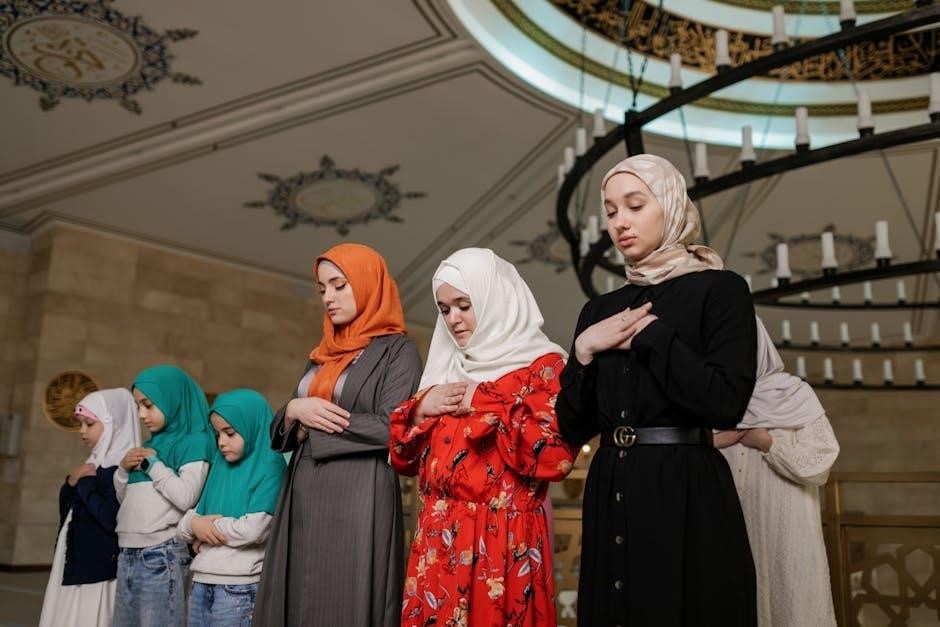The hymn “We Are Standing on Holy Ground” emphasizes the sacred presence of God and angels, written by Geron Davis in 1983. It highlights the sanctity of worship spaces, reminding believers they stand in God’s presence, a concept rooted in biblical events like Moses’ encounter with the burning bush. This song is widely used in Catholic and Protestant services, fostering reverence and awe, and is often sung during communion or moments of reflection. Its message transcends time, encouraging believers to live as a holy people, mindful of God’s forgiveness and justice. The hymn’s enduring relevance lies in its ability to inspire a deeper connection with the divine, making it a cornerstone of sacred worship. Its impact is evident in its widespread use across denominations, adapting to various cultural and liturgical traditions while maintaining its core theological themes. The hymn’s presence in worship services and its influence on contemporary Christian music highlight its significance in modern spirituality. By focusing on the sanctity of God’s presence, it calls believers to live with reverence and mindfulness of the holy ground they stand on. The hymn’s message of forgiveness and reconciliation resonates deeply, urging the community to embody Christ’s justice and mercy. Ultimately, it serves as a powerful reminder of the transformative power of worship and the enduring presence of God in the lives of believers.
1.1 The Significance of Holy Ground in Religious Contexts
Holy ground represents a sacred space where God’s presence is profoundly felt, as emphasized in the hymn. This concept is rooted in biblical events, such as Moses’ encounter with the burning bush (Exodus 3:5) and Jacob’s vision of angels (Genesis 28:12-17). In Catholic tradition, the tabernacle and the Eucharist embody this sanctity, symbolizing God’s dwelling among His people. The hymn reflects this reverence, urging believers to recognize the divine presence in worship spaces, fostering a deeper connection with the sacred and inspiring awe, praise, and mindfulness of God’s holy presence.
1.2 The Concept of Sacred Presence in Worship
The hymn “We Are Standing on Holy Ground” profoundly conveys the concept of sacred presence in worship, emphasizing that believers are in the immediate presence of God. The lyrics highlight the awareness of angels surrounding worshipers, creating a sacred atmosphere where reverence and awe are central. This idea aligns with the Catholic understanding of the Eucharist and tabernacle as embodiments of God’s presence. The hymn inspires believers to approach worship with mindfulness of the divine, fostering a deeper connection and humility in the presence of the Holy One, and acknowledging the transformative power of sacred worship experiences.

Biblical Foundations of Holy Ground
The Bible establishes holy ground as a place of divine encounter, where God’s presence is uniquely manifest, transforming it into sacred space for worship and reverence.
2.1 Moses and the Burning Bush (Exodus 3:5)
Moses’ encounter with the burning bush on Mount Horeb signifies a profound moment of divine presence. God instructed Moses to remove his sandals, declaring the ground holy because of His presence. This event underscores the idea of sacred space, where the ordinary becomes extraordinary through divine manifestation. The burning bush symbolizes God’s initiative to connect with humanity, setting a precedent for recognizing holy ground in worship and life. This biblical narrative establishes a pattern for reverence and awe in the presence of the Almighty, shaping theological understandings of sacred encounters.
2.2 Jacob’s Vision of Angels (Genesis 28:12-17)
Jacob’s vision of angels ascending and descending a ladder symbolizes a divine connection between heaven and earth. This encounter, occurring at Bethel, reveals God’s promise to be with Jacob wherever he goes. The presence of angels emphasizes the sacredness of the location, marking it as holy ground. Jacob’s response of reverence and worship highlights the importance of recognizing and honoring God’s presence in specific places. This biblical account illustrates how ordinary spaces can become extraordinary when God manifests His presence, reinforcing the concept of sacred ground in worship and life.
2.3 The Presence of God in the Tabernacle
The tabernacle, as described in Exodus, was a physical structure where God’s presence dwelled among the Israelites. Constructed with precise instructions, it symbolized God’s desire to reside with His people. The ark of the covenant, housed in the Holy of Holies, represented God’s throne on earth. The tabernacle’s design and rituals emphasized the sanctity of God’s presence, creating a sacred space where worship and sacrifice could connect humanity with the divine. This concept of holy ground underscores the idea that certain places can be set apart for encountering God’s glory and grace.
The Hymn “We Are Standing on Holy Ground”
This powerful hymn emphasizes reverence, acknowledging God’s sacred presence, and reflects biblical themes of holiness and worship, inspiring believers to approach God with awe and devotion.

3.1 Origins and Authorship of the Hymn
The hymn “We Are Standing on Holy Ground” was written by Geron Davis, an American Christian songwriter, and first recorded in the early 1980s. Its origins are rooted in evangelical worship traditions, emphasizing the sacredness of gathering in God’s presence.
The song gained popularity through Davis’s albums and has since been widely used in worship services globally, becoming a staple in contemporary Christian music and a powerful expression of reverence for God’s holy presence.
3.2 Lyrics and Theological Themes
The hymn “We Are Standing on Holy Ground” emphasizes reverence and awe, focusing on the theological themes of God’s presence and sacred space. The lyrics highlight the importance of recognizing God’s holiness in worship gatherings and daily life, encouraging believers to approach with humility and reverence. Themes of unity and community are also central, as the song often references the collective experience of worshiping together in God’s presence. These theological elements underscore the sanctity of worship and the transformative power of encountering God in a sacred context.
3.3 Musical Composition and Worship Usage
The hymn “We Are Standing on Holy Ground” features a simple yet powerful melody that enhances its reverent tone. Its moderate tempo and repetitive structure make it accessible for congregational singing, fostering unity in worship. Often accompanied by traditional instruments like pianos or organs, it creates a sacred atmosphere. The song is frequently used in liturgical settings, particularly during moments of reflection or communion, to emphasize the presence of God. Its versatility allows it to be adapted to both traditional and contemporary worship styles, making it a timeless piece in Christian worship.

Theological Implications of Standing on Holy Ground

Recognizing holy ground underscores God’s divine presence, evoking reverence and awe. It invites believers to embrace sacredness in worship, fostering humility and spiritual transformation through encounters with the divine.
4.1 The Sanctity of God’s Presence

The concept of standing on holy ground emphasizes the sanctity of God’s presence, which is both reverent and transformative. It signifies a divine encounter where the believer acknowledges God’s holiness and transcendence. This presence commands awe, humility, and worship, reminding us of the sacredness of being in God’s midst. The hymn underscores this by inviting worshippers to recognize the holy atmosphere, fostering a deeper connection with the divine. Such sanctity calls for moral purity and a mindful heart, ready to encounter God’s glory and grace in a sacred space.
4.2 Angels and Divine Accompaniment

The hymn reflects the biblical view that believers are accompanied by angels, emphasizing their role as divine messengers and guardians. Standing on holy ground signifies being in the presence of heavenly beings who worship and serve God. This accompaniment brings comfort, strength, and a deeper sense of reverence. The awareness of angels underscores the sacred nature of worship, reminding believers they are part of a larger spiritual community. This divine presence calls for humility, gratitude, and a heart ready to acknowledge God’s majesty and love.
4.3 Praise and Reverence in Worship
Recognizing the sacredness of holy ground fosters profound praise and reverence in worship. Believers are called to approach God with humility and awe, acknowledging His majesty. The hymn encourages worshippers to express gratitude and adoration, surrendering their lives to God’s glory. This mindset transforms gatherings into sacred encounters, where hearts are aligned with heaven’s worship. Praise becomes an act of reverence, reflecting the believer’s understanding of being in God’s presence, where every moment is an opportunity to honor and glorify Him.
The Role of the Tabernacle in Catholic Tradition
The tabernacle symbolizes God’s divine presence, housing the Eucharist as the real presence of Christ. It serves as a focal point for prayer, adoration, and devotion, reminding Catholics of God’s enduring dwelling among His people.

5.1 The Eucharist as Holy Ground
The Eucharist is revered as holy ground in Catholic tradition, embodying the real presence of Christ. The altar and tabernacle are sacred spaces where believers encounter God. The Eucharist transforms worship into an intimate communion with the divine, fostering reverence and awe. This sacrament is central to Catholic worship, uniting the faithful with Christ and one another. It signifies God’s abiding presence, inviting believers to live as His holy people. The Eucharist’s sanctity underscores the tabernacle’s role as a dwelling place of God, reinforcing the sacred nature of worship and community life.
5.2 Visiting the Blessed Sacrament
Visiting the Blessed Sacrament is a sacred act of devotion, fostering a profound encounter with Christ. Catholics often spend time in adoration, recognizing the tabernacle as a holy space where God dwells. Preparation for such visits includes prayer and reverence, emphasizing the sacredness of the moment. The quiet, reverent atmosphere encourages believers to deepen their relationship with God. This practice reflects the belief that holy ground is not just a physical place but a spiritual encounter with the divine. Regular visits inspire gratitude, peace, and a renewed commitment to living as God’s holy people.
5.4 The Tabernacle as a Symbol of God’s Dwelling
The tabernacle stands as a powerful symbol of God’s dwelling among His people, embodying the divine presence in a tangible way. Rooted in biblical tradition, it reflects the Old Testament’s Ark of the Covenant, where God resided among the Israelites. In Catholic worship, the tabernacle houses the Eucharist, emphasizing Christ’s real presence. It serves as a focal point of reverence, inviting believers to acknowledge God’s abiding nearness. This sacred vessel bridges heaven and earth, reminding the faithful of God’s enduring covenant and invitation to communion with Him.
The Beloved Community and God’s Forgiveness
The beloved community embodies unity, love, and reconciliation, rooted in God’s forgiveness. It calls believers to live harmoniously, reflecting divine mercy and fostering a culture of compassion and justice.
6.1 Living as God’s Beloved
Living as God’s beloved requires embracing divine love and grace in everyday life. It involves recognizing one’s identity as cherished by God, fostering humility, and reflecting this love through service to others. This lifestyle promotes spiritual growth, compassion, and a deepening relationship with God, inspiring believers to live with purpose and integrity, mindful of their sacred calling to embody God’s love in the world;
6.2 Justice and Mercy in Christian Living
Justice and mercy are core principles of Christian living, reflecting God’s character and command to love others. Justice involves upholding righteousness and advocating for the oppressed, while mercy extends compassion and forgiveness. Both are rooted in God’s nature, as seen in Scripture. Living on holy ground calls believers to integrate these values, ensuring fairness and kindness in all interactions. By pursuing justice and showing mercy, Christians honor God and create a more equitable world, embodying His love and righteousness in practical ways that transform lives and communities.
6.3 Forgiveness and Reconciliation
Forgiveness and reconciliation are essential for restoring relationships and reflecting God’s grace. Standing on holy ground calls believers to release grudges and seek unity, as Jesus emphasized in His teachings and example. Forgiveness frees individuals from bondage to resentment, fostering healing and peace. Reconciliation rebuilds broken connections, mirroring God’s reconciling work through Christ. Both practices demonstrate humility and love, aligning with the heart of Christian living and creating communities where God’s presence thrives, promoting wholeness and harmony among His people.

The Cultural and Liturgical Impact of the Hymn
The hymn has profoundly influenced worship practices, inspiring reverence and unity across cultures. Its liturgical use fosters a deeper connection to sacred traditions and divine presence.
7.1 Use in Worship Services and Liturgies
The hymn “We Are Standing on Holy Ground” is widely incorporated into worship services, evoking reverence and unity among congregations. Its powerful lyrics and melody create a sacred atmosphere, drawing worshippers into a deeper spiritual connection. Often sung during moments of reflection or communion, it emphasizes the sanctity of the space and God’s presence. The hymn’s adaptability makes it suitable for various liturgical contexts, including Eucharistic celebrations and special observances, fostering a sense of awe and devotion among participants.
7.2 Influence on Contemporary Christian Music
“We Are Standing on Holy Ground” has profoundly influenced contemporary Christian music by inspiring composers and worshippers alike. Its themes of reverence and sacred presence have shaped modern hymns and choruses. Many artists have drawn from its theological depth, incorporating similar motifs into their music. The hymn’s timeless message has bridged traditional and contemporary styles, making it a cornerstone in modern worship. Its impact is evident in the way it continues to inspire new generations of musicians and worshippers, ensuring its legacy endures in Christian music.
7.3 Adaptations and Interpretations
The hymn “We Are Standing on Holy Ground” has been adapted into various musical styles, from traditional choir arrangements to contemporary rock and gospel interpretations. Its versatility has allowed it to resonate across cultures and generations. Many artists have recorded their own versions, infusing the song with unique cultural and linguistic flavors. These adaptations highlight the hymn’s universal appeal while preserving its core theological message. Its ability to transcend genres has made it a beloved piece in diverse worship traditions worldwide.
Practical Applications of the Concept
Practical applications include creating sacred spaces, fostering mindfulness of God’s presence, and inspiring reverence in daily life, promoting a deeper spiritual connection and transformative worship experiences.
8.1 Creating Sacred Spaces for Worship
Creating sacred spaces for worship involves designing environments that foster reverence and mindfulness of God’s presence. These spaces often incorporate symbols, lighting, and music to enhance spiritual connection and reflection. By intentionally setting apart these areas, communities can encourage deeper prayer, meditation, and a sense of awe. The hymn “We Are Standing on Holy Ground” underscores the significance of such spaces, reminding believers of the transformative power of worship in a context that honors divine presence, thereby enriching their spiritual journey.
8.2 Mindfulness of God’s Presence in Daily Life
Mindfulness of God’s presence in daily life is rooted in the belief that every moment is sacred. This practice encourages believers to cultivate awareness of divine accompaniment, transforming ordinary tasks into acts of worship. By integrating prayer, reflection, and gratitude, individuals can honor God in their routines. The hymn “We Are Standing on Holy Ground” reminds us that mindfulness fosters reverence, turning life into a continuous offering to God, where every decision and action aligns with His will and purpose.
8.3 Inspiring Reverence and Awe in Faith
The concept of standing on holy ground fosters reverence and awe in faith, reminding believers of God’s transcendent presence. This mindset encourages humility, gratitude, and a deeper appreciation for the sacred. Worship practices, such as prayer and reflection, help sustain this reverence, while the hymn itself serves as a powerful reminder of God’s holiness. By cultivating awe, believers are drawn into a more intimate and respectful relationship with God, recognizing His divine nature and majesty in all aspects of life.

Reflection and Conclusion
The concept of holy ground invites reflection on God’s presence and human response. It transforms sacred spaces into daily reverence, inspiring lives of faith, gratitude, and worship.
9.1 The Timeless Message of Holy Ground
The timeless message of holy ground emphasizes the transcendent presence of God, bridging earthly and divine realms. It reminds believers of the sacredness of worship spaces and moments, inspiring reverence and awe. This concept transcends physical locations, urging followers to recognize God’s presence in all aspects of life. By honoring holy ground, communities affirm their identity as God’s people, called to live with integrity, compassion, and devotion. This enduring truth continues to inspire spiritual reflection and deeper connection with the divine.
9.2 The Call to Live as a Holy People
Recognizing we stand on holy ground calls believers to live as a holy people, consecrated to God’s purposes. This sacred identity demands a life of devotion, integrity, and love. Holy living is not just individual piety but a communal commitment to justice, mercy, and compassion. By embracing this call, believers reflect God’s holiness in their actions and attitudes, becoming His light in the world. This transformative lifestyle honors the sacredness of life and deepens the connection to the divine, fostering a community that embodies God’s love and righteousness.
9.3 The Enduring Relevance of Sacred Worship
Sacred worship remains a cornerstone of spiritual life, offering transcendence and connection to the divine. Through hymns like “We Are Standing on Holy Ground,” believers are reminded of the awe-inspiring presence of God. Worship fosters community, unity, and reverence, bridging the earthly and heavenly realms. Its enduring relevance lies in its ability to inspire humility, gratitude, and devotion, drawing people closer to God across generations. Sacred worship is not just a ritual but a living expression of faith, nurturing hearts and minds in the pursuit of holiness and eternal truth.
